
© Natasha Razina. (Click image for larger version)
Mariinsky Ballet
La Bayadère
★★★★✰
Berkeley, Zellerbach Hall
30 October 2019
www.mariinsky.ru
www.calperformances.org
The world’s great classical ballet companies rarely tour to the San Francisco Bay Area, and when they do tour here one is so abjectly grateful that one hates to pick a single nit or breathe a critical word – why press such profoundly good fortune? But nitpicking equals adoration among the balletomane’s favorite pastimes, so there are a few quibbles regarding the 30 October opening night of the Mariinsky Ballet’s La Bayadère, presented by Cal Performances in Zellerbach Hall on the campus of the University of California, Berkeley. But only a few.
Bay Area dance emphasizes the modern and the minimalist, so the Mariinsky’s production was a welcome ravishment of vibrant costumes, shimmering jewels, romantic storytelling and sheer entertainment, accompanied by the Mariinsky Orchestra playing Ludwig Minkus’ score. For three hours we were transported to a location that is theoretically India, but any resemblance is as vague as a late-morning dream.
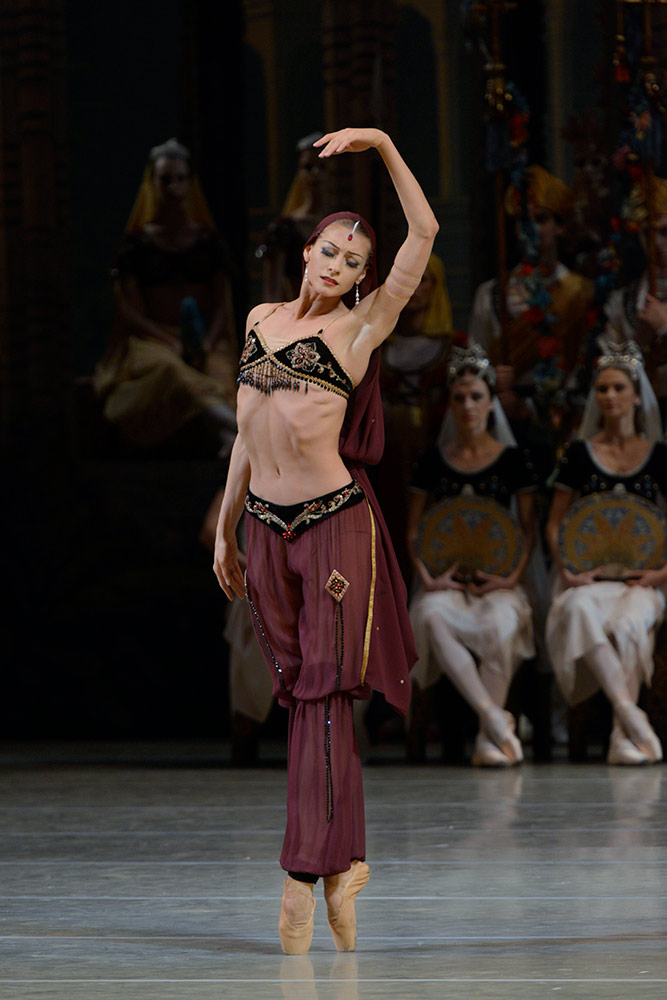
© Natasha Razina. (Click image for larger version)
Based on Marius Petipa’s libretto and choreography of 1877, revised to Soviet tastes by Vladimir Ponomarev and Vakhtang Chabukiani – who edited out the destruction of the temple – and plumped with latter-day dances by Konstantin Sergeyev and Nikolai Zubkovsky, this production comes across as a love story with enough seductive detail to render resistance futile – palm fronds and warm light that conjure tropical heat and humidity, flashes of saffron and fuchsia silk, gestures of courtly formality juxtaposed with forbidden embraces – rather than the political axe-grinding and valuation of cultural difference that have made late-19th-century ballets anathema in modern times.
Principal ballerina Ekaterina Kondaurova starred as the tragic heroine Nikiya, a temple dancer who is pursued by the High Brahmin (Soslan Kulaev), but is in love with the wealthy warrior Solor (principal Andrei Yermakov), who is in turn engaged to the haughty Gamzatti (Yekaterina Chebykina), who as the daughter of the Rajah (Andrei Yakovlev) would rather kill her rival than lose her high-status mate. It’s a tangled web of desire and betrayal, danced on opening night with superb skill but not quite enough chemistry to break hearts.

© Mark Olich. (Click image for larger version)
Yermakov’s elegant carriage and dynamic cross-lateral balance commanded attention from his Act I entrance, while Kondaurova’s coiled movement and stern gaze in the opening temple dance suggested reserves of emotion. When the two finally find time alone together, they flit about one another like joyful birds. For all their attempts to project longing and foreshadow their separation, their chemistry didn’t carry through to Acts II and III; true love must be felt, not shown, and Kondaurova’s death in Act II, at the scheming hands of Gamzatti and the Rajah, felt like a plot point rather than the destiny of a doomed soul. Also in Act II, David Zaleyev’s Golden Idol wanted both fireworks and control.
Second soloist Chebykina did the heavy lifting for all of them with her marvelously two-faced Gamzatti. All sweetness and blonde ringlets when the Rajah introduces her to Solor in their Act I betrothal ceremony, Chebykina is a vicious defender of her own interests, escalating from dagger stares to hair pulling to murder to secure the possession, if not the love, of Solor. Why she does this is a matter of the imagination, as Yermakov comes across as passive, not engaged enough to show his conflicted loyalties, much less any active desires of his own.
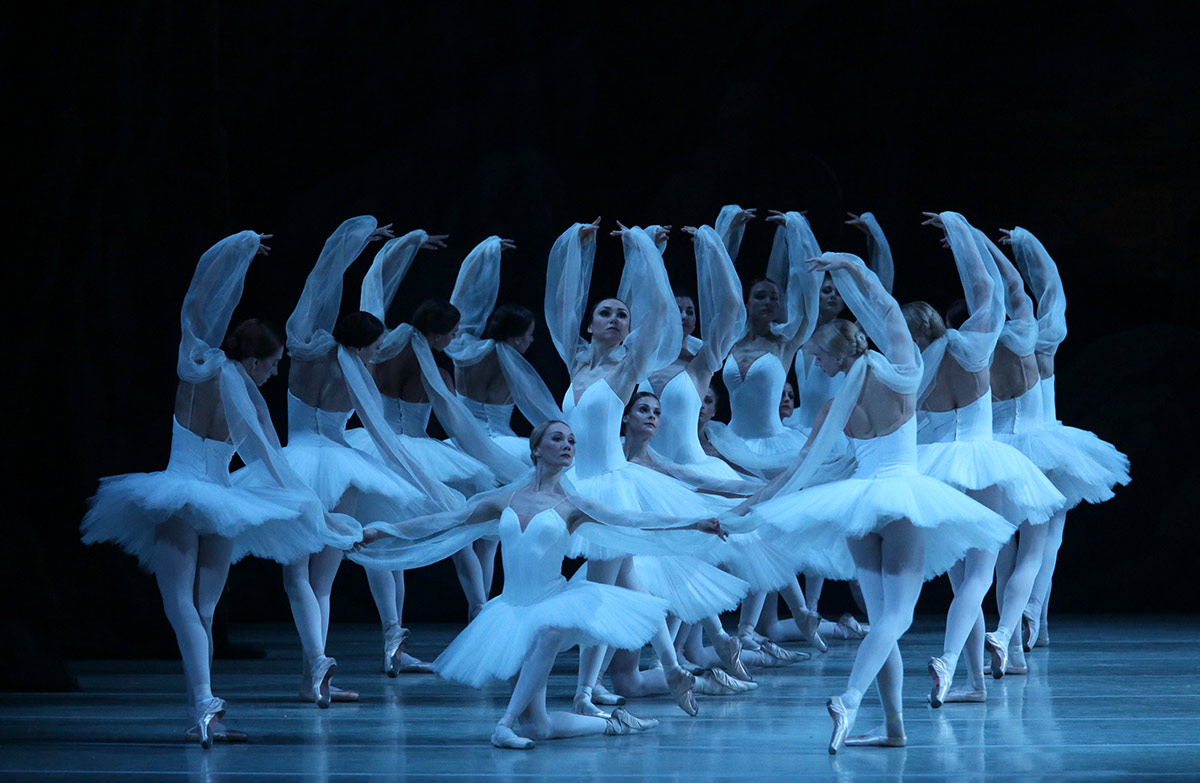
© Natasha Razina. (Click image for larger version)
So the impact of the dénouement, Act III’s Kingdom of the Shades, is less about Solor’s opium-laced vision of being reunited with Nikiya in the afterlife and essentially up to the corps de ballet and soloist Shades. The 32 corps women were wonderful in the famous descent from the Himalayas, draped in gossamer scarves and marching forward in unison arabesques. Renata Shakirova, Maria Shirinkina and May Nagahisa shone in their solo variations; Nagahisa was stunning in sequences of fouettés to arabesque, and sissones into beaten assemblés. After early shakiness, perhaps due to the flat stage rather than the raked stage the Russians are accustomed to, Kondaurova got her pirouettes back on track during the scarf duet, and Yermakov opened out in spectacular jumps in the coda; it was a bit too late to rescue the lovers, but who’s quibbling?












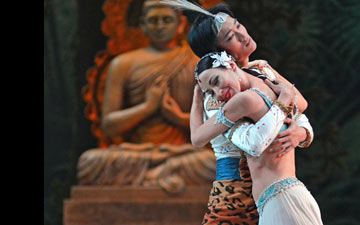
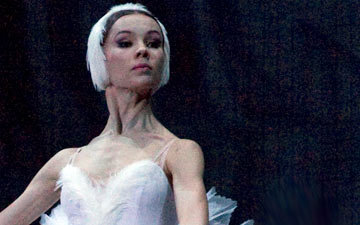
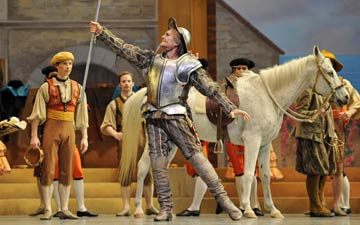


You must be logged in to post a comment.